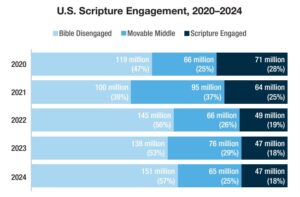
WASHINGTON (BP) — The continued drop in the number, rate and ratio of abortions in the United States is a cause for celebration but also for further efforts to protect children and assist women in need, Southern Baptist pro-life advocates say.
 The Centers for Disease Control and Prevention (CDC) reported Nov. 23 the total, rate and ratio of abortions in 2015 — the latest year for which statistics are available — all declined by two percent from 2014. The ratio and rate reached their lowest points since the Roe v. Wade ruling legalized abortion in 1973, while that year was the only one since the Supreme Court decision with fewer abortions than in 2015, according to numbers attributed to the CDC.
The Centers for Disease Control and Prevention (CDC) reported Nov. 23 the total, rate and ratio of abortions in 2015 — the latest year for which statistics are available — all declined by two percent from 2014. The ratio and rate reached their lowest points since the Roe v. Wade ruling legalized abortion in 1973, while that year was the only one since the Supreme Court decision with fewer abortions than in 2015, according to numbers attributed to the CDC.
Russell Moore, president of the Ethics & Religious Liberty Commission (ERLC), described the lower abortion rate as “good news. No doubt, the heroic advocacy of the pro-life community contributes to this lower rate.”
“Nonetheless, the continual assault on unborn children by the abortion industry should cause us to mourn,” Moore said in written comments for Baptist Press. “My prayer is that the pro-life movement will continue to make advances against the predatory forces that seek to snuff out the life of the vulnerable and prey upon vulnerable women.”
David Uth, senior pastor of First Baptist Church in Orlando, Fla., expressed his gratitude to Jesus for the demonstration that the work of pregnancy care centers like that sponsored by his church and other pro-life endeavors are having an impact.
“I think all of it has made a difference, no doubt,” Uth told BP in a phone interview. “I think that we have to be very, very aware that this has been an effort that has had many fronts.”
In 2015, 638,169 abortions were reported to the CDC, while the rate was 11.8 abortions per 1,000 women who were 15 to 44 years of age. The ratio was 188 abortions per 1,000 live births.
The decline in all three measurements was especially dramatic from 2006 to 2015, the period analyzed by the CDC in its latest report. The number of abortions fell by 24 percent during that span, while the rate and ratio decreased 26 and 19 percent, respectively.
While the CDC’s yearly report is helpful, its statistics are incomplete. States are not required to report information on abortion, and three — California, Maryland and New Hampshire — have not provided data to the CDC for at least eight years.
The Guttmacher Institute, which is affiliated with the abortion rights movement, covers all 50 states in its research and has reported similar declines in the abortion total and rate. In January 2017, Guttmacher said the rate fell to 14.6 abortions per 1,000 women in 2014, marking a decline of 14 percent since its most recent survey in 2011. In its census of all known abortion providers in the country, Guttmacher found abortions in 2014 totaled 926,190, a decrease of more than 30,000 from the previous year.
Its report also has limitations, Guttmacher has acknowledged. For instance, it reported only 58 percent of facilities it believes provided abortions in 2014 responded to the survey. Guttmacher used state health department information for 20 percent of facilities and made estimates on another 17 percent.
Various reasons are offered for the continued decline, which goes back to 1990 for the abortion total and the early to mid-1980s for the rate and ratio of abortion.
Abortion-rights advocates credit better contraceptive use and fewer abortion clinics. Seven states have only one abortion clinic in operation, according to an ABC News report in June. Forty Days for Life — which sponsors semi-annual outreaches at abortion clinics — reports 99 clinics have closed and 186 clinic workers have quit after its campaigns since 2007.
Meanwhile, pro-lifers point to such factors as the growth and ministry of pregnancy care centers, the advent of ultrasound technology, more state laws restricting abortion and requiring health and safety standards, and efforts to educate the public on the humanity of the unborn child. Surveys also have shown the millennial generation is more pro-life than older Americans.
Americans United for Life (AUL) has led the way in helping states enact laws in protecting unborn lives and women’s health. It has provided model legislative language and legal support. States have approved about 260 pro-life laws in the last five years and more than 540 since 2010, according to AUL. Those laws have included such measures as health and safety requirements for clinics and doctors, ultrasound mandates, and prohibitions on late-term procedures and abortions based on sex, race or genetic abnormality.
Even AUL, however, cited a decline in requests for abortion as the primary factor.
Research, even by pro-abortion organizations, has shown “that while the inability of many dangerous, fly-by-night abortion centers to comply with basic women’s protection laws has forced some abortion centers to close, the abortion rate has dropped precipitously over the last 25 years chiefly because demand for abortion has fallen,” said Steven Aden, AUL’s chief legal officer and general counsel, in written remarks for BP. “This means that abortion is becoming ‘the forgotten right’ — what the law made legal in 1973 with Roe, it could not make acceptable.”
Uth told BP that pregnancy centers — like his church’s First Life Center for Pregnancy — have opened the eyes of many through technology to the reality of unborn life.
“I think that technology has changed the game,” he said, adding statistics at the center have shown when a woman is willing to have an ultrasound “it’s unbelievable the number of women that changed their mind. I think we’re living in an age of technology, and that has helped us to try to show and convince women of the truth.”
Efforts such as the ERLC’s Psalm 139 Project reflect the pro-life recognition of the importance of technology by helping place ultrasound machines in pregnancy resource centers across the country.
The services provided by a pregnancy care center are vital to help a church not only proclaim “pro-life truth” but to help women who think abortion is their only option, Uth told BP.
“[A] pregnancy center is the church’s way of saying, ‘Yes,’ not just, ‘No,'” he said. “And so we have been able to say, ‘Yes,’ to so many — that ‘Yes, we’ll help you;’ ‘Yes, we’ll find a way for you to make it through this;’ and, ‘Yes, we’ll even help you make a decision about your child, whether you’re going to keep the child or you’re going to give the child up for adoption.’ And so in my opinion, it’s just a whole Gospel approach to the issue of the sanctity of human life.”
The center’s ministry has had an ongoing impact in the church, Uth said.
On Dec. 2, Uth invited people in the congregation who had needs to come forward and also asked members who wanted to help meet a need to come forward and stand by them.
One of those who came forward and stood with someone in need was a woman whom the pregnancy center helped to choose life for her unborn child “and changed her life,” Uth told BP. “And now she’s married. Now she’s found Jesus. She is living a great life. And she came and stood with somebody, saying, ‘I’m going to help you, because I know what it’s like. I’ve been there.’ So we’re seeing the fruit of the pregnancy center now in terms of people who are helping to bless others.”
The CDC’s latest report showed a dramatic increase in the use of non-surgical abortion methods. The typical, two-step procedure described as medical or chemical abortion in the first eight weeks of gestation rose from 11.3 percent in 2006 to 24.2 percent in 2015, according to the CDC.
The fourth annual Evangelicals for Life conference, which is sponsored by the ERLC, will address abortion and pro-life ministry work Jan. 16-18 at McLean Bible Church in Vienna, Va., a suburb of Washington, D.C.













